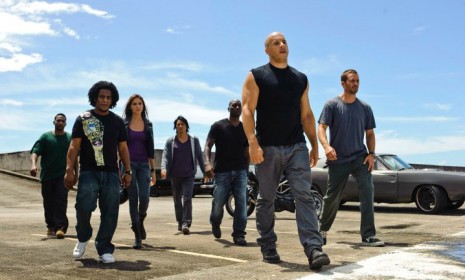How the 'Fast and Furious' movies are secretly progressive
The street-racing franchise is "loud, ludicrous, and visually incoherent," says Wesley Morris at The Boston Globe. But it also offers a bold vision of racial unity

Television and pop music promote a relatively color-blind vision of America, writes Wesley Morris at The Boston Globe — just witness the racial melange that is The Black-Eyed Peas. The movie industry, however, offers few films that reflect modern-day diversity. A notable exception: The careening Fast and Furious series. It may not be high art, but the franchise, "in its Utopian way, puts blacks, whites, Asians, Hispanics, and their various combinations on equal footing." Since the diverse characters are "unified by automotive exhilaration" instead of, say, social justice, the films' progressivism is often overlooked. But the fact that the movies "feature race as a fact of life as opposed to a social problem or an occasion for self-congratulation" is what makes them so important. Here, an excerpt:
Movies about race still tend to be self-congratulatory (Crash) or mine tension for comedy, the way 48 Hours and its offspring have. As a rule, a movie starring a white guy and a black guy is a movie about a white guy and a black guy. The enormous success of 2009’s The Blind Side, in which Sandra Bullock makes a black teenager one of the family, demonstrates that America isn’t post-racial. It is thoroughly mired in race — the myths that surround it, the guilt it inspires, the discomfort it causes, the struggle to transcend it.
The Fast and Furious movies, by contrast, are free of this angst. They’re basically a prolonged party for a ring of street-racing urban car thieves... It was a place the movies had never precisely seen before: gangs of young people of different races unified by automotive exhilaration. There were blacks, Asians of all kinds, Mexicans, Michelle Rodriguez, and whatever Vin Diesel and Jordana Brewster are. Friction exists among the factions, but it’s just the organic sort you expect from a bunch of marginal kids engaged in a variety of illegal hobbies.
The Week
Escape your echo chamber. Get the facts behind the news, plus analysis from multiple perspectives.

Sign up for The Week's Free Newsletters
From our morning news briefing to a weekly Good News Newsletter, get the best of The Week delivered directly to your inbox.
From our morning news briefing to a weekly Good News Newsletter, get the best of The Week delivered directly to your inbox.
Read the entire article at The Boston Globe.
A free daily email with the biggest news stories of the day – and the best features from TheWeek.com
-
 Political cartoons for December 14
Political cartoons for December 14Cartoons Sunday's political cartoons include a new White House flag, Venezuela negotiations, and more
-
 Heavenly spectacle in the wilds of Canada
Heavenly spectacle in the wilds of CanadaThe Week Recommends ‘Mind-bending’ outpost for spotting animals – and the northern lights
-
 Facial recognition: a revolution in policing
Facial recognition: a revolution in policingTalking Point All 43 police forces in England and Wales are set to be granted access, with those against calling for increasing safeguards on the technology